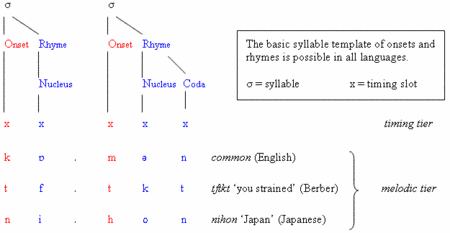Syllable: Difference between revisions
imported>Kevin Allbee mNo edit summary |
imported>John Stephenson m (rv to keep spellings consistent throughout) |
||
| Line 1: | Line 1: | ||
The '''syllable''' is a unit of | The '''syllable''' is a unit of organisation in [[phonology]], the system responsible for the patterns of sounds and signs in [[language]]. Typically, a syllable consists of a [[vowel]] and at least one [[consonant]], though various combinations are possible, including single vowels. The number and type of syllables in a word, phrase or sentence may strongly influence [[stress (linguistics)|stress]] and [[intonation]] throughout. | ||
[[Image:Syllable.gif|450px|right|thumb|Onset-Nucleus-Coda: one view of the structure of the syllable, showing the syllabification of three words in English, [[Japanese language|Japanese]] and [[Berber languages|Berber]].]] | [[Image:Syllable.gif|450px|right|thumb|Onset-Nucleus-Coda: one view of the structure of the syllable, showing the syllabification of three words in English, [[Japanese language|Japanese]] and [[Berber languages|Berber]].]] | ||
Revision as of 03:22, 4 April 2007
The syllable is a unit of organisation in phonology, the system responsible for the patterns of sounds and signs in language. Typically, a syllable consists of a vowel and at least one consonant, though various combinations are possible, including single vowels. The number and type of syllables in a word, phrase or sentence may strongly influence stress and intonation throughout.
In linguistics, the existence of syllables as organisers of speech sounds and sign language movements is typically used to explain observations about what is possible in language, from native speakers’ perceptions of how many 'beats' there are in a word to the possible ordering of segments such as c, a and t in cat: why English speakers 'feel' there are two syllables in mother but only one in fire, and why *nxalr is not a possible word in English and, indeed, most languages.
The existence of the syllable as an abstract phonological unit that limits the possible sequences of segments is not uncontroversial, and its use in mainstream linguistics literature has been inconsistent. Theories predating the arrival of the currently-mainstream generative phonology, as well as more recent approaches from within generativism itself, have called into question or even outright rejected the syllable in favour of other behavioural explanations from within both phonology and phonetics.
Evidence for the syllable
- Main article: Evidence for the syllable
Evidence for the existence of syllables in the world's languages can be divided into evidence both external and internal to the system of language. The former refers to ideas about syllables in various cultures, such as their use in poetry, as well as speakers' 'intuitions' about them. Internal evidence refers to actual linguistic behaviour (e.g. positions where speakers modify a pronunciation), which can perhaps be better accounted for if it is assumed that 'rules' of phonology operate within the syllable rather than some other domain.
There are several pieces of external evidence for the syllable:
- Its place in various cultures around the world; for instance, there are many writing systems, known as syllabaries, that write syllables rather than individual phonemes (distinctive segments);
- Their use in language games, such as Pig Latin, where syllables are moved around;
- Native speaker intuitions; people often 'feel' that words are not the fundamental unit of speech, but are further divided into smaller units;
- Speech errors and wordplay seem to keep syllables intact; e.g. town drain is a possible spoonerism for down train, but *nown traid is not;
- Typology (language classification according to structure): most languages seem to have syllables, and certain types are particularly common.
Internal evidence involves a more complex analysis of linguistic behaviour. For example, word stress in many languages seems dependent on the number and type of syllables, and the ordering of speech segments tends to group into syllable-like sequences of consonants and vowels, typically CV.
Historical definitions of the syllable
Although humankind has been aware of syllables throughout recorded history, as evidenced by the existence of syllabaries, a formal definition remained elusive until the late 20th century. Sometimes the syllable was defined on loosely phonetic grounds, while on other occasions a more phonological description was sought.
The syllable as a phonetic phenomenon
The structuralist linguist Charles F. Hockett, drawing on the 1947 work of Kenneth and Eunice Pike, referred to the syllable as a "structural unit", analysing it into Immediate Constituents (capitalisation in original) of an onset, a peak and a coda.[1] He went on to claim that their origin was phonetic and pulmonic (of the lungs): it appeared that the rhythm of pulmonic exhalation correlated with the production of syllables.[2] This was a similar view to the idea that syllables were associated with 'chest pulses'.[3]
However, this phonetic definition of the syllable did not adequately describe its behaviour. Whilst phonetic analysis of speech often finds a correlation between breaks in voicing and syllable margins, there are many instances where boundaries are absent from the acoustic waveform.[4] As a result of this lack of correspondence between phonetic observations and phonological operations, a satisfactory acoustic or auditory definition is yet to be found.[5] Furthermore, changes in pronunciation within syllables often seem unmotivated by phonetic factors; for example, English speakers vary a good deal in how much and when they glottalise the phoneme /t/ in words such as hat; this process occurs syllable-finally, but is not obligatory.[6]
Footnotes
References
- Bell A & Hooper JB (1978) Issues and evidence in syllabic phonology. In Bell A & Hooper JB (eds) Syllables and Segments. Amsterdam: North-Holland Publishing Company. pp.3-22.
- Fujimura O & Erickson D (1997) Acoustic phonetics. In Hardcastle WJ and Laver J (eds) The Handbook of Phonetic Sciences. Oxford: Blackwell. pp.65-115.
- Hockett CF (1955) A Manual of Phonology: Memoir 11. Baltimore, MD: Waverly Press, Inc.
- Hockett CF (1958) A Course in Modern Linguistics. New York: Macmillan.
- Pike KL & Pike E (1947) 'Immediate Constituents of Mazateco syllables.' International Journal of American Linguistics 13: 78-91.
- Laver J (1994) Principles of Phonetics. Cambridge: Cambridge University Press.
